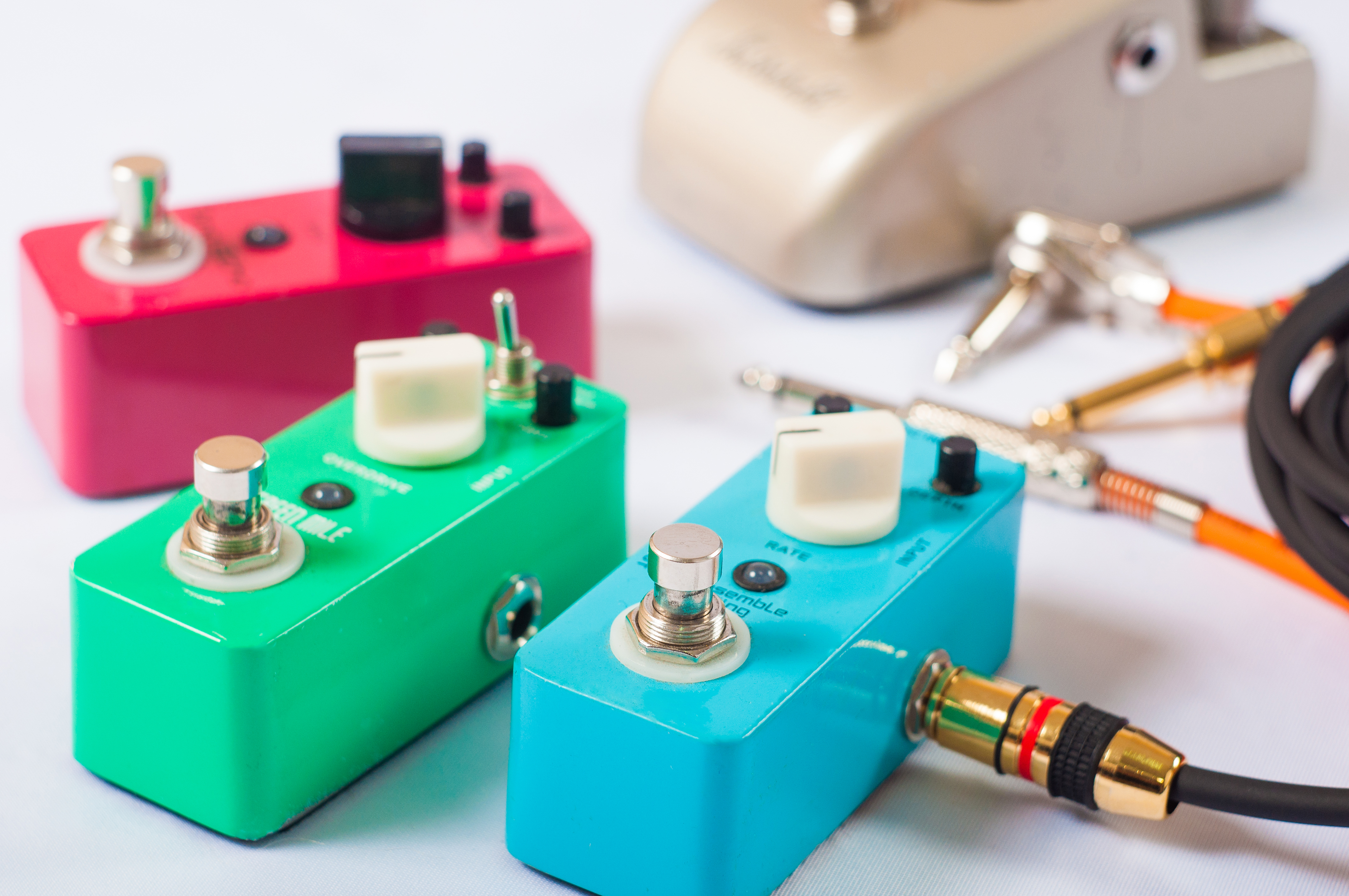
Compression will almost always be used on any instrument, regardless of whether it’s guitar, bass, vocals, or strings. When it comes to mixing music for mass consumption, a compressor will also always be used on the overall music track to tame the peaks and dips in volume. However, this article will focus more on compression pedals for guitar.
When it comes to guitar pedals, I tend to avoid ranking them in a top 10 list, or something akin to that, as guitar pedals are a very subjective topic. Instead, I will provide a list of five commonly used compressor pedals that span across different price ranges to give you a good idea of what may fit your needs.
In case you’re not sure what a compressor is and what the different parameters do, here is a brief overview before we dive into the list of pedals.
A compressor is an effect that controls the volume of an instrument. It automatically lowers the volume on the loud sections and boosts the volume on the quiet sections. It basically reduces the dynamic range of the overall volume, resulting in a more consistent sounding audio track or instrument.
Compressors are often used to increase sustain, and although that is one of its uses, that’s not all that it does. A compressor can also be used to provide more punch in the sound (eg. getting your kick drum to pop out more in the mix), or it can also be used to fatten up your tone. Some compressors do their job transparently, meaning they do not color the original sound of your instrument, while others provide very heavy coloring.
What your compressor can do really depends on the settings of the parameters and whether those parameters are even adjustable on the pedal in the first place.
Many simple compressors only provide two adjustable knobs: one for adjusting overall volume and another for adjusting the amount of compression on the signal.
However, just in case you go for a pedal with more adjustable parameters, here are the typical parameters of a compressor pedal and what they do:
(Click on each + to read more)
So let’s say for example, you’d like to play some funk music, and you’re playing simple triad chords with a funk picking pattern.
The most important sound out of your guitar that you’d like to have stand out in the mix is the initial attacks of the notes as that’s the key element that drives the rhythm forward, but you don’t want the actual sound of the chords to be too loud as there are other instruments in the overall mix providing chords.
In that case, you’d probably set your compressor to have a slow to medium attack speed, so that the initial onsets of the played notes don’t get compressed, allowing them to pop out of the mix, while the rest of the chord gets compressed so it doesn’t clash with the other instruments.
The threshold will probably be medium to low, as it’s not necessary to really squash the signal, and your ratio will probably be around 3:1 or 4:1 so the chord is still audible, but definitely attenuated. This is just one example of adjusting the settings so that you can get a specific sound; your settings for a burning lead guitar tone for a fiery solo will very likely be completely different (fast attack, higher threshold, and higher ratio).
Compressors will generally only give you up to these eight parameters to play around with, and very often they only provide four, or even two, parameters. So now that we have an understanding of how each parameter will affect our sound, let’s check out some popular compressor pedals!
1. MXR Dyna Comp
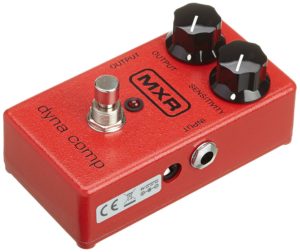
Brand New: $79.99
Used: $55 - $65
Let’s begin with one of the most recognizable and iconic compressor pedals on the market.
This crimson red pedal has been spotted over the years on the pedalboards of players such as John Frusciante, Noel Gallagher, The Edge, Eric Johnson, Pete Townshend, and many, many more. Its popularity probably comes from its price, ease-of-use, and unique coloring of tone.
This pedal rocks two very simple and intuitive knobs: one for sensitivity (threshold) and another for level.
However, don’t let its simple design fool you, as this compressor can provide a lot of sustain that will allow your lead guitar tones to shine through the band.
Buy here
2. Xotic SP Compressor
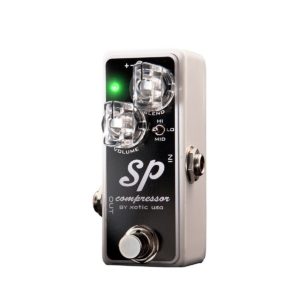
Brand New: $132
Used: $99 - $115
Here is another really easy to use compressor pedal that provides a transparent (doesn’t color your tone) sound. On the front panel of the pedal, the only parameters that you can adjust via knobs are blend and volume, while a three way switch allows you to choose a compression setting. The settings available are hi, mid, and lo.
When you remove the backplate of the pedal, four additional internal dip-switches can be found which allow you to adjust the attack, release, hi-cut (a basic EQ function), and dB cut (a volume attenuator). On top of having a number of extra adjustable parameters, this pedal also comes in a very compact size that will find its space on many cluttered pedalboards.
Buy here
However, some musicians may find that this pedal is a little limited in its adjustable parameters, considering the fact that all the internal dip-switches and the three-way switch on the front panel only give you a couple of settings. This stands in contrast of variable knobs. If you find that this is the case for you, keep on reading!
3. Wampler Ego
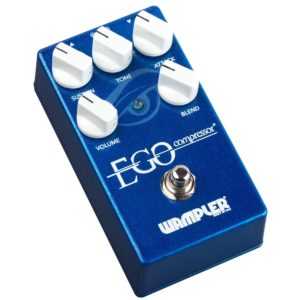
Brand New: $199.97
Used: $165 - $185
Although the Wampler Ego begins to creep into the pricier side of compressor pedals, its popularity is a testament to its effectiveness. This compressor can be found on the pedalboards of musicians like Brad Paisley, Tosin Abasi, Wayne Sermon, and Keith Urban.
The Wampler Ego is another transparent compressor that provides adjustable knobs for sustain, tone, attack, volume, and blend. Unlike the Xotic SP Compressor, the Wampler Ego provides variable knobs for all of its parameters so you can really begin to carve out your specific sound.
In terms of ease of use, this pedal begins to call for a better technical understanding of how compressors work compared to the previous two.
Buy here
4. Empress Effects Analog Compressor
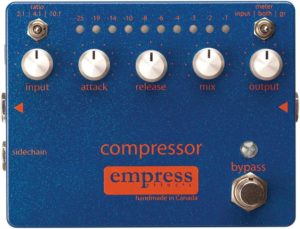
Brand New: $249
Used: $220 - $230
The Empress Compressor is often touted as a “studio-grade” compressor that rivals rack mounted units found in professional recording studios. What sets it apart from the other compressors found on this list is a LED meter that can show you the amount of gain reduction being caused by the compressor. This can be useful for adjusting your output gain to match the uncompressed signal.
This pedal provides you with input, attack, release, mix, output, and ratio parameters that can be adjusted. However, it should be noted that the ratio setting is selected via a switch, and only three ratios of 2:1, 4:1, and 10:1 can be selected.
Of the five pedals listed here, this may be the most versatile one, but it is also the largest in size. The high versatility of this pedal will also call for a better understanding of how to use compressors, so this may not be for you if you’re new to compressors. However, if you already know how to use compressors, this pedal will allow you to get really, really specific with your sound, allowing you to use this compressor over literally all styles of guitar playing.
Buy here
5. Mooer Yellow Comp
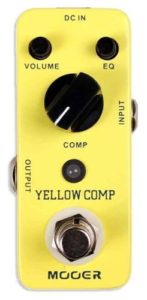
Brand New: $48.99 - $88
Used: $30 - $50
Here’s a unique little budget compressor.
This pedal is made by Chinese manufacturer Mooer, and they design their pedals to be budget micro sized clones of other well-known pedals. Putting aside the ethics of this practice, it’s astounding how some of their pedals can get really close to what they are attempting to clone, and this micro pedal is no exception.
The Yellow Comp is a clone of the Diamond Compressor, another well-known industry-standard compressor. The method used for the compression effect in this pedal is known as optical compression and this results in a very transparent compression with no coloration of tone at all.
Limitations:
- The small footprint of this pedal does limit the number of adjustable parameters it offers, resulting in only volume, compression, and EQ variable knobs.
- Another limitation of this pedal is its lack of a battery compartment.
- All the previous pedals on this list offer the option of using a 9v battery, while the Yellow Comp only allows the option of using a power adapter. This shouldn’t be a problem if you already have some kind of effects pedals power supply, but if you’re solely relying on batteries for your pedals, then you may have to look elsewhere.
- Another odd thing about this pedal is the varying price points for a brand new copy. I believe this is a result of Mooer being a relatively new player in the effects pedal industry. About two years ago, any brand new Mooer pedal could be bought for about $50, but it seems that many retailers are now selling these pedals for $80 and above.
The initial low cost of these pedals may be due to Mooer trying out different price points to get an idea of how much the average consumer is willing to pay for their high quality clones. In order to get the best deal for a brand new Mooer pedal, you may have to spend some time looking around different sites to get the best price. As of this moment, it appears Amazon may have the best deal, but that may change over time.
Buy here
Final note
Compression tends to be quite a tricky effect to play around with initially, and it is sometimes very subtle and unnoticeable to the untrained ear. However, it is without a doubt one of the most important tools in any musician’s utility belt, and you will be hard pressed to find a pedalboard belonging to a professional musician without some kind of compressor.
The number of ways compression can be used is almost limitless and compression is also often an “always-on” effect. Many people find that compression is essential to their “base” (clean signal) tone, myself included.
Due to the learning curve of compressors, I often find myself recommending simpler compressors such as the MXR Dyna Comp to people who are still new to guitar effects pedals. However, after some time, you will find that simple compressors have many limitations, and they don’t allow you to really sculpt a specific tone.
If you are at that point where simple compressors just don’t cut it, and you’d like to learn how to really work your way around this handy tool, I suggest playing around with a compressor in a music editing software (known as a digital audio workstation).
Begin by playing around with extreme compression to really exaggerate the effect; this will teach you how each parameter affects the sound. Once you’ve gotten the hang of adjusting every parameter to get a really specific sound, that’s when you can begin playing with more complex guitar pedal compressors. Having more adjustable parameters is often helpful because different styles of playing will require different compression settings. For example, lead lines will often call for a faster attack and higher threshold setting in order to create more sustain and a balanced volume, while funk guitar rhythms may call for a slower attack setting in order to let the initial attack pop through the mix.
At the end of the day, compressors are really like any other effect, the more you understand the different adjustable parameters, the closer you can get to that dream tone you hear in your head.
If you’d like more recommendations for compressor pedals, or more advice on how to work a compressor, feel free to leave a comment in the comment section!

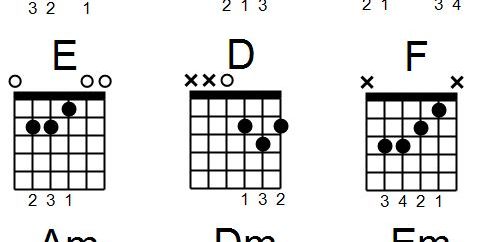
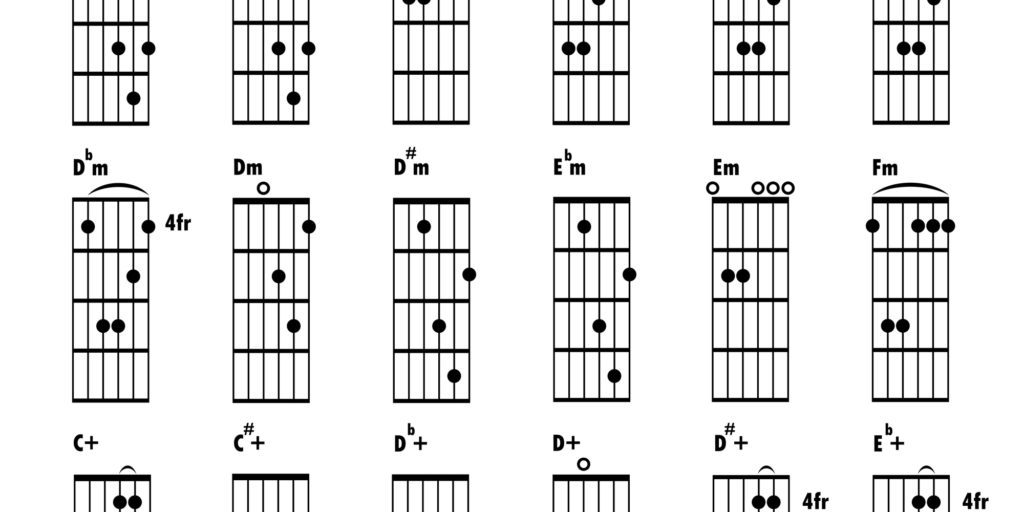
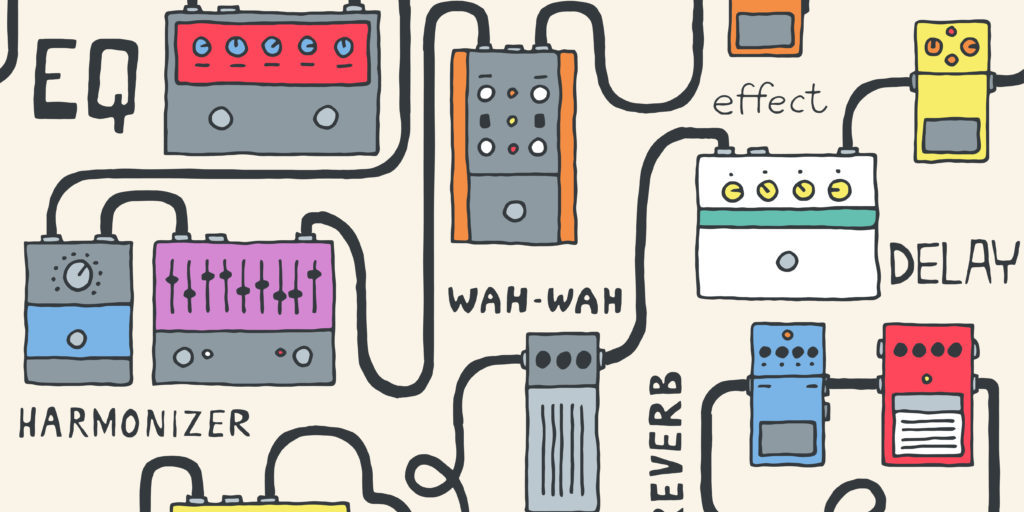
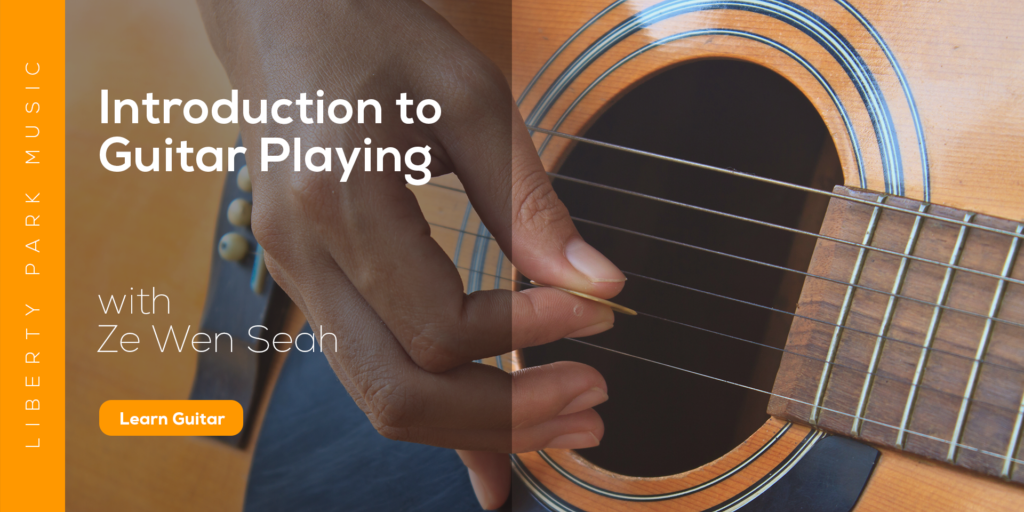
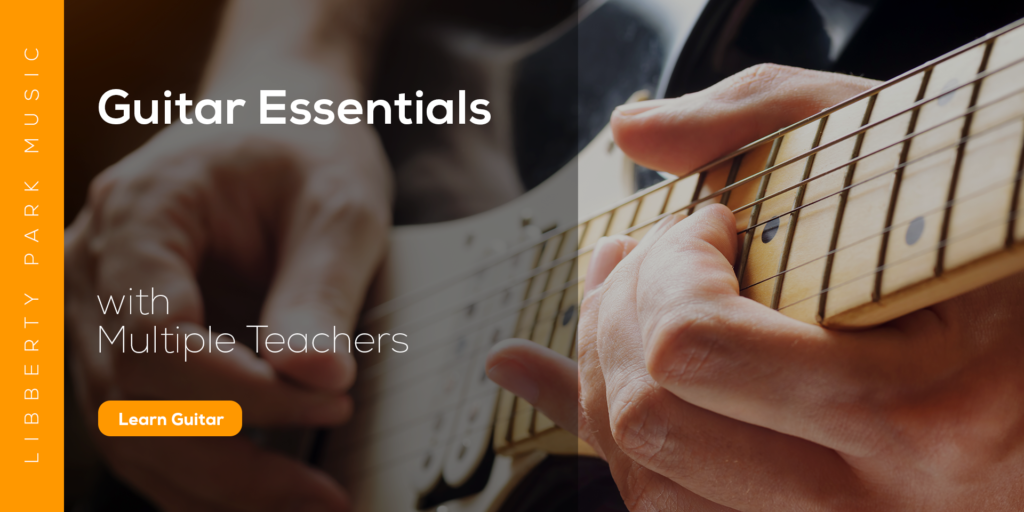
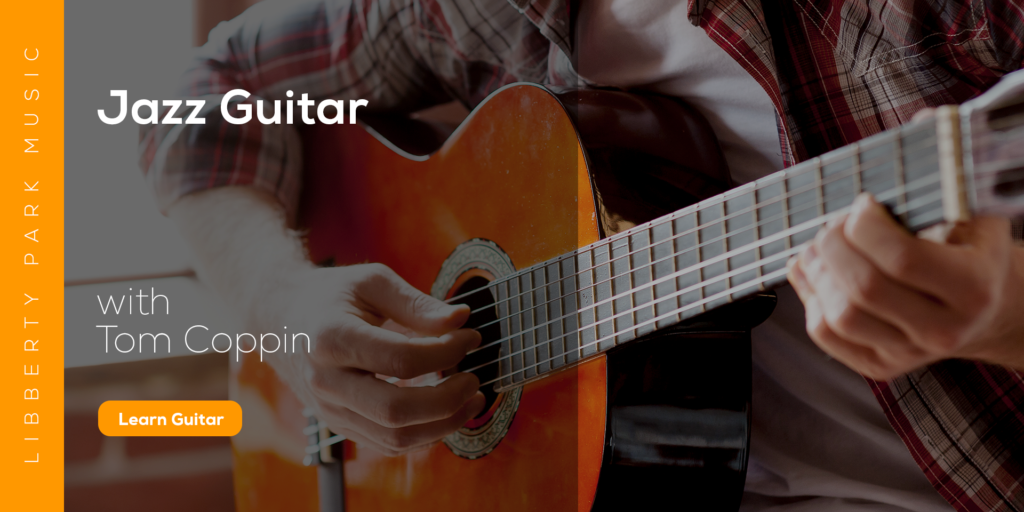
thanks for the information